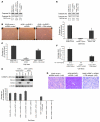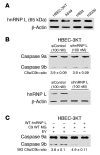hnRNP L regulates the tumorigenic capacity of lung cancer xenografts in mice via caspase-9 pre-mRNA processing
- PMID: 20972334
- PMCID: PMC2964989
- DOI: 10.1172/JCI43552
hnRNP L regulates the tumorigenic capacity of lung cancer xenografts in mice via caspase-9 pre-mRNA processing
Abstract
Caspase-9 is involved in the intrinsic apoptotic pathway and suggested to play a role as a tumor suppressor. Little is known about the mechanisms governing caspase-9 expression, but post-transcriptional pre-mRNA processing generates 2 splice variants from the caspase-9 gene, pro-apoptotic caspase-9a and anti-apoptotic caspase-9b. Here we demonstrate that the ratio of caspase-9 splice variants is dysregulated in non-small cell lung cancer (NSCLC) tumors. Mechanistic analysis revealed that an exonic splicing silencer (ESS) regulated caspase-9 pre-mRNA processing in NSCLC cells. Heterogeneous nuclear ribonucleoprotein L (hnRNP L) interacted with this ESS, and downregulation of hnRNP L expression induced an increase in the caspase-9a/9b ratio. Although expression of hnRNP L lowered the caspase-9a/9b ratio in NSCLC cells, expression of hnRNP L produced the opposite effect in non-transformed cells, suggesting a post-translational modification specific for NSCLC cells. Indeed, Ser52 was identified as a critical modification regulating the caspase-9a/9b ratio. Importantly, in a mouse xenograft model, downregulation of hnRNP L in NSCLC cells induced a complete loss of tumorigenic capacity that was due to the changes in caspase-9 pre-mRNA processing. This study therefore identifies a cancer-specific mechanism of hnRNP L phosphorylation and subsequent lowering of the caspase-9a/9b ratio, which is required for the tumorigenic capacity of NSCLC cells.
Figures









Comment in
-
Living or dying by RNA processing: caspase expression in NSCLC.J Clin Invest. 2010 Nov;120(11):3798-801. doi: 10.1172/JCI45037. Epub 2010 Oct 25. J Clin Invest. 2010. PMID: 20972326 Free PMC article.
Similar articles
-
hnRNP U enhances caspase-9 splicing and is modulated by AKT-dependent phosphorylation of hnRNP L.J Biol Chem. 2013 Mar 22;288(12):8575-8584. doi: 10.1074/jbc.M112.443333. Epub 2013 Feb 8. J Biol Chem. 2013. PMID: 23396972 Free PMC article.
-
HnRNP L-mediated regulation of mammalian alternative splicing by interference with splice site recognition.RNA Biol. 2010 Jan-Feb;7(1):56-64. doi: 10.4161/rna.7.1.10402. Epub 2010 Jan 21. RNA Biol. 2010. PMID: 19946215
-
SRSF1 regulates the alternative splicing of caspase 9 via a novel intronic splicing enhancer affecting the chemotherapeutic sensitivity of non-small cell lung cancer cells.Mol Cancer Res. 2011 Jul;9(7):889-900. doi: 10.1158/1541-7786.MCR-11-0061. Epub 2011 May 26. Mol Cancer Res. 2011. PMID: 21622622 Free PMC article.
-
Splicing factors of SR and hnRNP families as regulators of apoptosis in cancer.Cancer Lett. 2017 Jun 28;396:53-65. doi: 10.1016/j.canlet.2017.03.013. Epub 2017 Mar 14. Cancer Lett. 2017. PMID: 28315432 Review.
-
Caspase 9b: a new target for therapy in non-small-cell lung cancer.Expert Rev Anticancer Ther. 2011 Apr;11(4):499-502. doi: 10.1586/era.11.23. Expert Rev Anticancer Ther. 2011. PMID: 21504315 Review. No abstract available.
Cited by
-
Regulation of HNRNP family by post-translational modifications in cancer.Cell Death Discov. 2024 Oct 4;10(1):427. doi: 10.1038/s41420-024-02198-7. Cell Death Discov. 2024. PMID: 39366930 Free PMC article. Review.
-
An integrative framework identifies alternative splicing events in colorectal cancer development.Mol Oncol. 2014 Feb;8(1):129-41. doi: 10.1016/j.molonc.2013.10.004. Epub 2013 Oct 19. Mol Oncol. 2014. PMID: 24189147 Free PMC article.
-
Interplay between miR-574-3p and hnRNP L regulates VEGFA mRNA translation and tumorigenesis.Nucleic Acids Res. 2017 Jul 27;45(13):7950-7964. doi: 10.1093/nar/gkx440. Nucleic Acids Res. 2017. PMID: 28520992 Free PMC article.
-
Splice variants of cytosolic polyadenylation element-binding protein 2 (CPEB2) differentially regulate pathways linked to cancer metastasis.J Biol Chem. 2017 Oct 27;292(43):17909-17918. doi: 10.1074/jbc.M117.810127. Epub 2017 Sep 13. J Biol Chem. 2017. PMID: 28904175 Free PMC article.
-
Large-scale analysis of genome and transcriptome alterations in multiple tumors unveils novel cancer-relevant splicing networks.Genome Res. 2016 Jun;26(6):732-44. doi: 10.1101/gr.199935.115. Epub 2016 Apr 13. Genome Res. 2016. PMID: 27197215 Free PMC article.
References
-
- Philchenkov A, Zavelevich M, Kroczak TJ, Los M. Caspases and cancer: mechanisms of inactivation and new treatment modalities. Exp Oncol. 2004;26(2):82–97. - PubMed
Publication types
MeSH terms
Substances
Grants and funding
LinkOut - more resources
Full Text Sources
Other Literature Sources
Medical
Molecular Biology Databases

